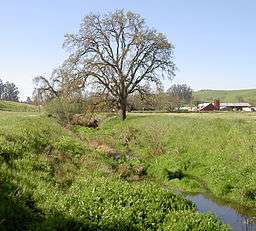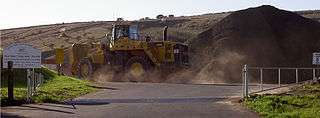Washoe Creek
| Washoe Creek | |
| perennial stream | |
 Channelized lower reaches of Washoe Creek, in spring. | |
| Name origin: Washo language | |
| Country | United States |
|---|---|
| State | California |
| Region | Sonoma County |
| Tributaries | |
| - left | Gossage Creek |
| City | Cotati |
| Source | |
| - location | 3 mi (5 km) southwest of Cotati, California |
| - elevation | 400 ft (122 m) |
| - coordinates | 38°18′25″N 122°44′58″W / 38.30694°N 122.74944°W [1] |
| Mouth | Laguna de Santa Rosa |
| - location | west of Rohnert Park, California |
| - elevation | 85 ft (26 m) [1] |
| - coordinates | 38°21′0″N 122°43′59″W / 38.35000°N 122.73306°WCoordinates: 38°21′0″N 122°43′59″W / 38.35000°N 122.73306°W [1] |
| Length | 2 mi (3 km) |
Washoe Creek is a perennial stream located in Sonoma County, California. It is about 2 mi (3 km) long and discharges to the Laguna de Santa Rosa.[2]
Washoe Creek rises in the low lying Meacham Hills southwest of the city of Cotati. It descends to the northeast, flowing under Roblar Road and Stony Point Road. It then turns northward and parallels Stony Point Road, crossing under West Sierra Avenue and Madrone Avenue. Gravenstein Highway (State Route 116) crosses the creek, which then enters an artificial channel. Gossage Creek enters from the west, and shortly thereafter the creek ends at a confluence with the Laguna de Santa Rosa just west of Rohnert Park.
The original native riparian vegetation was likely riparian woodland, with Valley Oak savanna and grassland on the upland east and west.[3] The native habitats have been largely altered or replaced, due to the modern uses of grazing, agriculture, and urban development. In stream nitrate concentrations are noticeably higher for Washoe Creek than other watercourses within the Laguna de Santa Rosa watershed.[4] The lower reach is under consideration for a restoration project.[5]
History
This area was settled at least as early as 2000 BC by the Coast Miwok peoples, who built small villages along the banks of Washoe Creek and other local watercourses. These early peoples were gatherers and utilized resources of the creek as well as upland areas for subsistence. In 1833 this entire area around present Cotati was part of a Mexican land grant.
One of the area's American pioneers was Robert Ayres, who in 1859 built Washoe House near the creek's headwaters.[6]

In the early 1900s, a rock quarry on Peterson Road (Gossage Creek watershed) was abandoned, and a new quarry was begun on Stony Point Road.[7] The creek lies just across Stony Point Road from the current quarry site.
See also
References
- 1 2 3 U.S. Geological Survey Geographic Names Information System: Washoe Creek
- ↑ Santa Rosa Quadrangle, Fifteen minute series, USGS Quadrangle Map, U.S. Government Printing Office, Washington DC (1958)
- ↑ Environmental Impact Report for the West Gravenstein Specific Plan, Earth Metrics Report 7526, city of Cotati (1989)
- ↑ Summary of water quality data for the Laguna de Santa Rosa Basin
- ↑ Laguna de Santa Rosa Foundation Restoration Plans
- ↑ "Markeroni: Washoe House".
- ↑ "Stony Point Rock Quarry Inc.: Our History". Retrieved 2007-12-02.